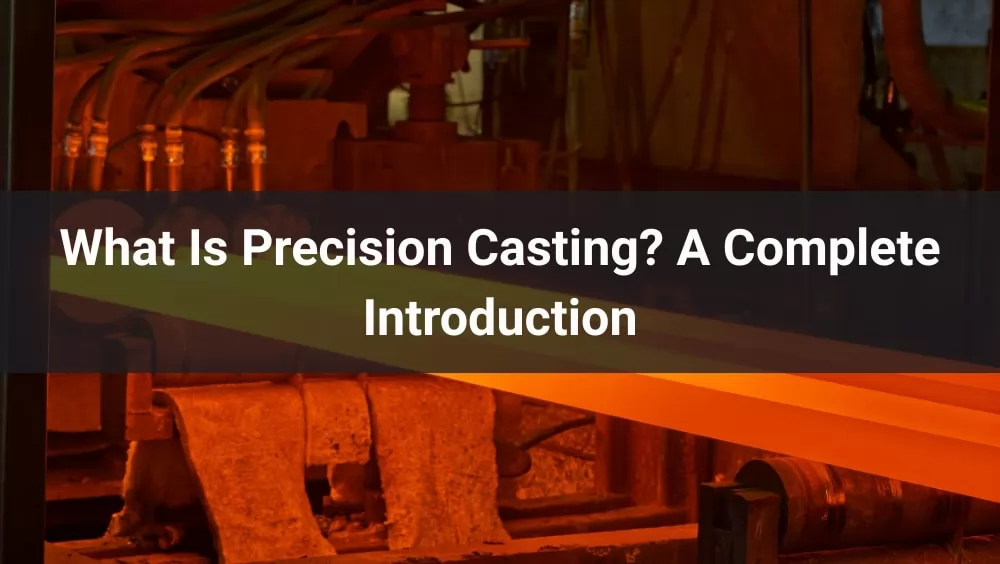
Ever wondered how manufacturers achieve incredibly detailed and dimensionally accurate metal components for aerospace, automotive, and medical industries? The answer lies in precision casting—also known as investment casting—a centuries-old process that’s been refined into one of the most advanced manufacturing techniques available today. Whether you're an engineer, product designer, or sourcing specialist, understanding precision casting can help you make smarter decisions in production and procurement.
In this guide, we’ll break down what precision casting is, how it works, what materials are commonly used, and where it stands out from other manufacturing methods. By the end, you'll have a solid grasp of why this technique is trusted across critical industries—and how it might be the solution for your next project.
Table of Contents
- 1. Introduction to Precision Casting
- 2. How Precision Casting Works: Step-by-Step Process
- 3. Key Materials Used in Precision Casting
- 4. Advantages of Precision Casting
- 5. Common Applications Across Industries
- 6. Precision Casting vs. Other Casting Methods
- 7. FAQs About Precision Casting
- 8. Conclusion: The Future of High-Precision Manufacturing
Introduction to Precision Casting
Precision casting, also known as investment casting or lost-wax casting, is a manufacturing process used to create metal parts with extremely tight tolerances, intricate shapes, and smooth surfaces. This method has been around for thousands of years but has evolved into a highly technical and precise modern technique essential to many industries.
Today, precision casting is favored when complex geometries, durability, and excellent surface finishes are critical. From aerospace components to surgical instruments, this method delivers reliable, high-quality results.
How Precision Casting Works: Step-by-Step Process
| Process | Description |
|---|---|
| Wax Pattern Creation | Create a wax model using a metal mold; multiple patterns may form a tree for batch casting. |
| Shell Building | Dip wax model in ceramic slurry and sand to form a durable mold layer by layer. |
| Dewaxing | Melt out wax from hardened ceramic shell, leaving a clean hollow mold. |
| Metal Pouring | Preheat mold and pour molten metal to fill the detailed cavity accurately. |
| Cooling and Shell Removal | Let the metal solidify, then break the ceramic shell to reveal the rough casting. |
| Cleaning and Finishing | Remove excess material, perform grinding or machining, and inspect for final specs. |
Step 1: Wax Pattern Creation
The process begins by creating a wax model that is an exact replica of the part to be produced. This wax pattern is formed using a metal mold, ensuring consistency in shape and dimension. Multiple wax patterns may be attached to a central wax sprue to create a "tree" for mass production.
Step 2: Shell Building
The wax assembly is repeatedly dipped into a ceramic slurry and then sprinkled with fine sand or refractory material. Each layer is allowed to dry before the next is applied. This step is repeated multiple times to build up a durable ceramic shell capable of withstanding the high temperatures of molten metal.
Step 3: Dewaxing
After the ceramic shell has dried and hardened, it undergoes a dewaxing process. The wax inside is melted out—usually in an autoclave or high-temperature furnace—leaving a clean, hollow mold. This is the origin of the term "lost-wax casting."
Step 4: Metal Pouring
The hollow ceramic mold is preheated to remove any residual moisture and to reduce thermal shock. Molten metal is then poured into the mold, filling the cavity left by the wax. The metal flows into even the most intricate details of the mold, reproducing the original design with high accuracy.
Step 5: Cooling and Shell Removal
Once the metal has been poured, it is allowed to cool and solidify inside the mold. After cooling, the ceramic shell is carefully broken away, typically using vibration or mechanical means, revealing the metal casting underneath.
Step 6: Cleaning and Finishing
The rough casting undergoes several finishing processes such as cutting, grinding, sandblasting, or machining to achieve the final specifications. Any remaining ceramic material is removed, and the part is inspected for quality and dimensional accuracy.
Key Materials Used in Precision Casting
| Material Type | Example Alloys | Common Applications | Notes |
|---|---|---|---|
| Ferrous Alloys | Stainless Steel 304, 316, Carbon Steel, Tool Steel | Aerospace, automotive parts, surgical tools, valves, pumps | Excellent strength, wear resistance, and corrosion resistance. Preferred for structural or load-bearing applications. |
| Non-Ferrous Alloys | Aluminum 6061, 7075; Copper; Bronze; Brass | Marine parts, decorative components, electronics housings, engine parts | Lightweight and corrosion-resistant. Often used when weight and appearance are factors. |
| Super Alloys | Nickel-based alloys (e.g., Inconel), Cobalt alloys | Gas turbines, high-temperature components, aerospace engines | Retain strength and stability at extreme temperatures. Expensive but essential for critical environments. |
| Titanium Alloys | Ti-6Al-4V | Medical implants, aerospace parts, sporting goods | High strength-to-weight ratio and excellent biocompatibility. More challenging to cast but highly valued. |
| Refractory Mold Materials | Silica, Zircon, Alumina | Used to create ceramic shells | These materials can withstand the intense heat of molten metals and help produce a smooth surface finish. |
Precision casting supports a wide range of metals and alloys, each chosen based on the specific application, strength requirements, and environmental conditions. Ferrous alloys, such as Stainless Steel 316 and carbon steels, are known for their excellent strength, corrosion resistance, and durability. These materials are commonly used in aerospace components, medical instruments, and industrial machinery where mechanical performance is critical.
On the other hand, non-ferrous alloys like Aluminum 7075, bronze, and brass offer lightweight properties, high conductivity, and good corrosion resistance. These materials are ideal for automotive parts, marine applications, and decorative components that benefit from a balance of strength and lower weight. Superalloys and titanium alloys are also used for high-temperature or high-strength applications, including turbine blades and orthopedic implants.
Beyond metal selection, the ceramic molds used in precision casting are just as important. Refractory materials such as silica, zircon, and alumina are used to build the molds that can withstand extreme heat during metal pouring. These materials help ensure smooth surfaces and dimensional accuracy in the final cast parts. By carefully selecting both casting metals and mold materials, manufacturers achieve exceptional quality and precision in every component produced.
Advantages of Precision Casting

1. High Dimensional Accuracy
Precision casting produces components with extremely tight tolerances, often eliminating the need for additional machining. This is ideal for industries where exact fit and finish are crucial, such as aerospace and medical devices.
2. Complex Geometries
This method allows for the creation of intricate shapes and internal structures that would be difficult or impossible to achieve with traditional machining or forging techniques.
3. Smooth Surface Finish
The ceramic mold used in the process creates a naturally smooth surface on the cast product, reducing the need for extensive post-processing or surface treatment.
4. Wide Material Compatibility
Precision casting supports a variety of metals and alloys, including both ferrous and non-ferrous types. This makes it suitable for a broad range of industrial applications.
5. Material Efficiency
Because precision casting closely replicates the final shape of the part, it minimizes material waste compared to subtractive manufacturing methods.
6. Lower Production Costs for Complex Parts
When producing intricate parts in medium to large quantities, precision casting can be more cost-effective than machining or assembling multiple components.
7. Design Flexibility
Engineers and designers can incorporate detailed features such as logos, threads, and thin walls directly into the cast part, enhancing both function and aesthetics.
Common Applications Across Industries

Aerospace
Precision casting is widely used in the aerospace industry for parts such as turbine blades, fuel nozzles, and engine components. These parts require tight tolerances, high strength-to-weight ratios, and excellent heat resistance to perform under extreme conditions.
Automotive
In automotive manufacturing, precision casting is ideal for producing complex parts like exhaust manifolds, gearboxes, and brake components. The process enables mass production of durable and lightweight components that contribute to vehicle efficiency and performance.
Medical
Precision casting plays a crucial role in the medical field, where it’s used to manufacture orthopedic implants (such as joint replacements), surgical instruments, and dental tools. These items require high precision, biocompatibility, and smooth surface finishes.
Marine and Industrial Equipment
In marine and heavy industry, precision casting is used for parts such as pump impellers, valve bodies, and pipe fittings. These components must be corrosion-resistant, structurally sound, and reliable in demanding environments like seawater or high-pressure systems.
Precision Casting vs. Other Casting Methods

| Feature | Precision Casting | Sand Casting | Die Casting |
|---|---|---|---|
| Surface Finish | Excellent | Rough | Good |
| Dimensional Accuracy | High | Medium | High |
| Tooling Cost | Moderate | Low | High |
| Suitability for Complex Shapes | Excellent | Fair | Good |
Precision casting stands out for its ability to produce highly detailed and accurate parts with smooth finishes, making it ideal for complex geometries and critical applications.
In contrast, sand casting is more cost-effective for simpler, larger parts, while die casting is preferred for high-volume manufacturing with less emphasis on design complexity.
FAQs About Precision Casting

Q1: What exactly is precision casting?
Precision casting, also called investment casting, is a process that creates highly detailed metal parts using wax molds and ceramic shells.
Q2: What materials can be used in precision casting?
It supports a wide range of metals like stainless steel, aluminum, bronze, and specialty alloys used in aerospace and medical fields.
Q3: How accurate is precision casting?
It offers excellent dimensional accuracy, often within ±0.1 mm, making it ideal for complex and tight-tolerance components.
Q4: Is precision casting better than sand casting?
Yes, for detail and finish. Precision casting provides smoother surfaces and more complex shapes than sand casting.
Q5: What industries rely on precision casting?
Industries like aerospace, automotive, medical, and energy use it for parts that need high strength, accuracy, and durability.
Conclusion
Precision casting isn’t just about achieving fine detail—it’s about producing complex parts with consistent quality, excellent surface finishes, and minimal machining requirements. From intricate turbine blades to specialized medical components, this process brings both efficiency and reliability to the manufacturing world.
If you're looking for a precision casting partner that blends expert craftsmanship with modern technology, consider working with Besser. Our commitment to quality, material traceability, and customer collaboration makes us a trusted choice for clients worldwide. Let’s bring your designs to life—with precision.



